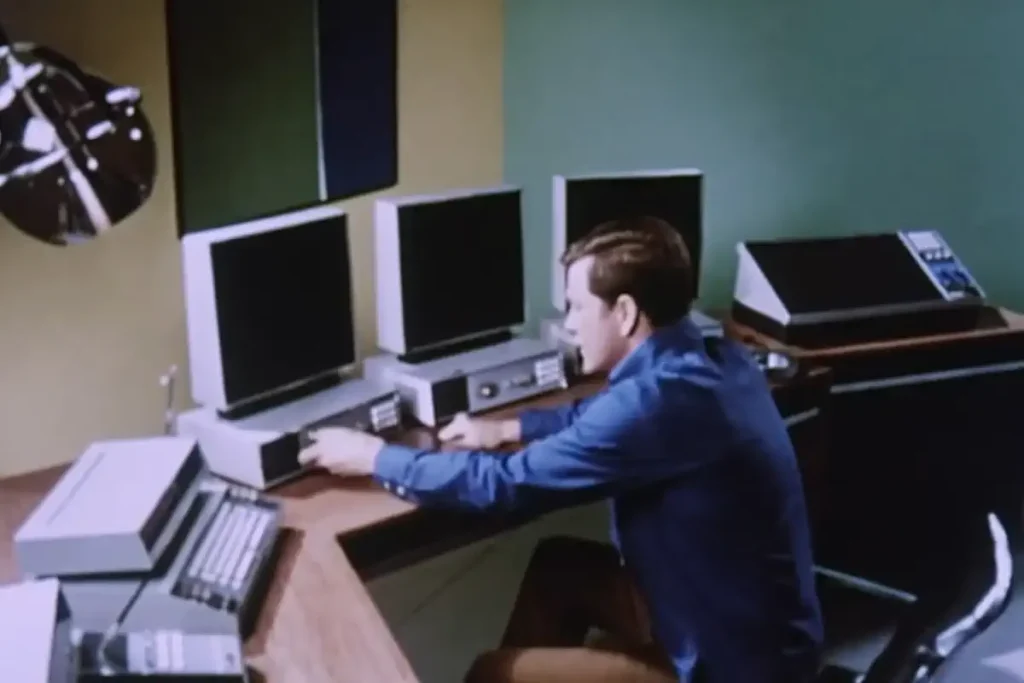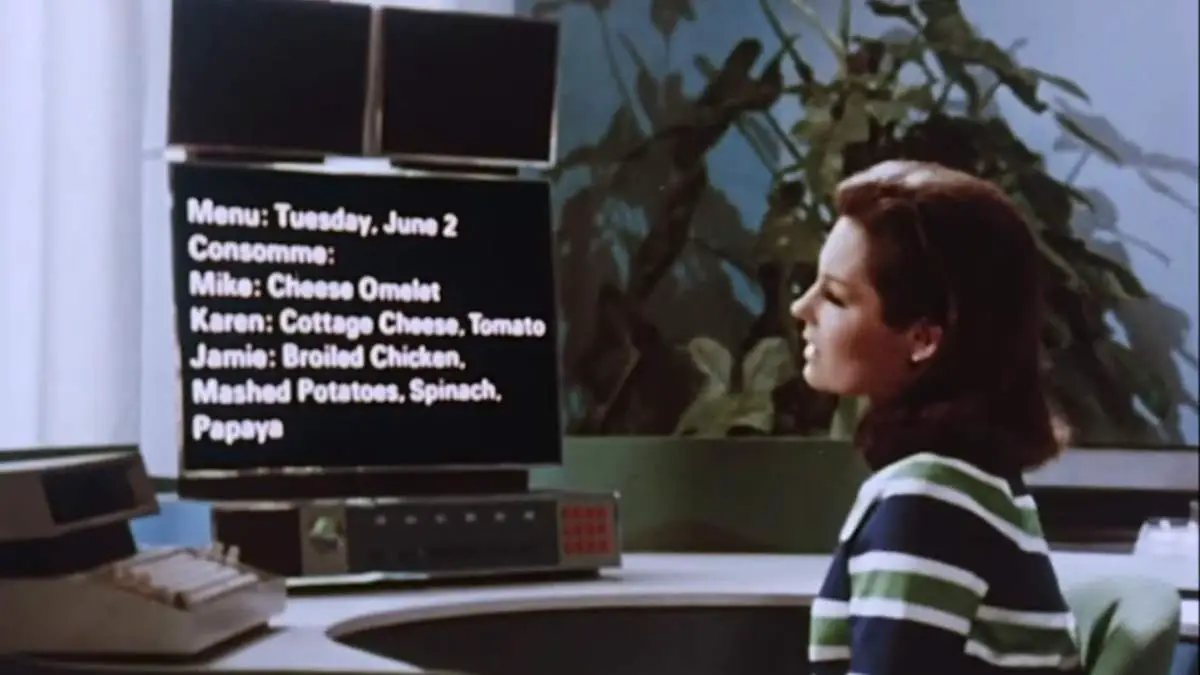In 1967, as space-age fantasies ignited imaginations across the globe, the then Philco-Ford, now Ford Motor Company, attempted to capture the future’s heart and soul in a brief cinematic journey. The film titled “1999 AD” catapulted its audience three decades into the future, offering a tantalizing glimpse of everyday life for a quintessential American family, the Shores. Viewing this projection of the future now, the film emerges as a treasure trove of intriguing insights – a harmonious blend of eerily accurate predictions and glaring blind spots, seasoned with the unmistakable charm of the 1960s.
The World of 1999: A Vision from 1967
In 1967, a captivating video titled “1999 AD” painted an enthralling vision of the future as dreamt by the generation of the 1960s. It was a testament to the dreams of a generation fuelled by rapid technological changes and the conquest of outer space.
The narrative opens with a young boy designing his home on an air-based board, hinting at our quest for defining the modernity of home living. And then there’s a mention of a “central home computer” that plays the role of “secretary, librarian, banker, teacher, medical technician, bridge partner,” and more. This prediction isn’t far from our modern Siri, Alexa, or Google Assistant, bearing witness to the visionary thoughts of the 1960s.
Education too was touched upon. Young James Shaw is portrayed attending formal school just two mornings a week, with the rest of his learning coming from an “education center” at home. This seems prescient now with the rise of online education and remote learning, a trend accelerated by global events like the COVID-19 pandemic.
The video also emphasized leisure and convenience, particularly in food preparation. The “instant society” as described has now been realized in our world of fast food, microwavable meals, and meal-kit deliveries. More impressively, there’s the mention of fingertip shopping, which is undeniably a precursor to our online shopping habits.
Notably, the video highlighted the role of the home as a health monitoring center. While we don’t have full-blown health stations in our homes yet, wearable techs like Fitbit and the Apple Watch perform similar functions, tracking vitals and health metrics.
However, the video’s envisioning of the future wasn’t always spot-on. The “honeycomb” style housing and an entirely “maintenance-free” home might not be our reality, but they represent the utopian ideals of the age.

One element that is both touching and optimistic is the continued emphasis on human relationships. Despite the technological advancements, the family still gathers for meals, children still play (albeit with advanced tech toys), and art remains a staple in leisure activities.
However, the most impressive foresight might be the “electronic correspondence machine” which alludes to our email and instant messaging platforms. While the video might not have foreseen the explosion of social media, it did predict a world where instant communication would be a central part of our lives.
Perhaps the most endearing part of the video is its genuine optimism. It sees the future as full of possibilities, with technological advancement making life more convenient and enriched. This positive outlook is something that should be preserved, especially as we now stand at the threshold of further monumental changes like AI and quantum computing.
In retrospect, “1999 AD” from 1967 encapsulates the hopes, dreams, and aspirations of a generation. While some of these dreams have been realized, others remain in the realm of imagination. Yet, the spirit of the video serves as a reminder: the future, whatever it holds, is shaped by the dreams we dare to dream today.
The Shadows of Patriarchy
The Shore family, comprised of a mother, father, and a sprightly young son, serves as the canvas upon which the filmmakers painted their vision of the imminent 21st century. What’s uncanny is that certain fragments of this vision would fit seamlessly into today’s tapestry of life. The film heralded an era of instantaneous communication, an omnipresence of screens dictating various facets of daily life, and an undying obsession with health and fitness tracking. In these aspects, the film showcased a crystal ball-like clarity, capturing the zeitgeist of the future with an accuracy that can only be applauded.
However, as is the fate of many a seer, there were areas where the film’s lens blurred. While the marvels of technology were elaborated upon with much enthusiasm, the film surprisingly overlooked the sweeping cultural evolutions that the turn of the century would bring. Moreover, it remained blissfully ignorant of the impending environmental storms that would challenge humanity’s relationship with Mother Earth.
But perhaps the film’s most profound oversight lies in its portrayal of gender dynamics. It’s here that the 1960s’ roots become glaringly evident, casting shadows that are too significant to ignore. The film presents a household that is still very much ensnared in the patriarchal norms of the 20th century.

The mother, while surrounded by futuristic gadgets, remains confined to the roles of meal preparer and primary caregiver. She dotes on her son and manages the household, while her husband, the astrophysicist, steps into the shoes of the quintessential breadwinner. He holds the financial reins of the family, including a watchful eye on his wife’s expenditures, reflecting a paradigm where women were yet to break free from the chains of domesticity and financial dependence.
This myopic representation underscores the broader societal challenge of the time: the inability to envision a future where women would shatter the glass ceilings and emerge as equals in all spheres of life. Despite the awe-inspiring technological advancements, the film appears to be anchored to a past where gender roles were firmly defined and rarely questioned.
Another fascinating element is the film’s unabashed techno-utopian optimism. The future, as “1999 AD” sees it, is devoid of the environmental challenges we grapple with today. The oceans, instead of bearing the brunt of pollution and the cataclysmic consequences of rising temperatures, flourish in biodiversity. This is a future where humanity’s harvest from the sea isn’t tainted by the specters of overfishing or coral bleaching.
With an ambiance more reminiscent of the idyllic “Leave It to Beaver” rather than the dystopian hues of “Black Mirror”, the film serves as a testament to the commercialized vision of the future. Through the looking glass of capitalism, technological products, and advancements emerge as saviors, magically erasing societal problems. This perspective, while comforting, is a stark reminder of the feedback loop between commercial depictions and invention. It underscores how conglomerates, like the Ford Motor Company, have not just predicted but actively sculpted the contours of modern history.
In conclusion, “1999 AD” is more than just a retro-futuristic film. It’s a mirror reflecting the dreams, aspirations, and limitations of a bygone era. While it dazzles with its predictions of technological marvels that we now take for granted, it also serves as a somber reminder of the societal chains that once bound us. And as we march forward, armed with lessons from the past and dreams of an even more incredible future, one hopes that our visions are not just technologically enriched but also socially enlightened.
Sources
- Aeon Video Channel on Youtube
- Space Shuttle Endeavour’s Touchdown Meets Columbia’s Salute [An amazing photo from the past] - February 29, 2024
- Moon Landings: All-Time List [1966-2024] - February 23, 2024
- From Orbit to Ordinary: 10 Earthly Applications of Space Technology - January 23, 2024

